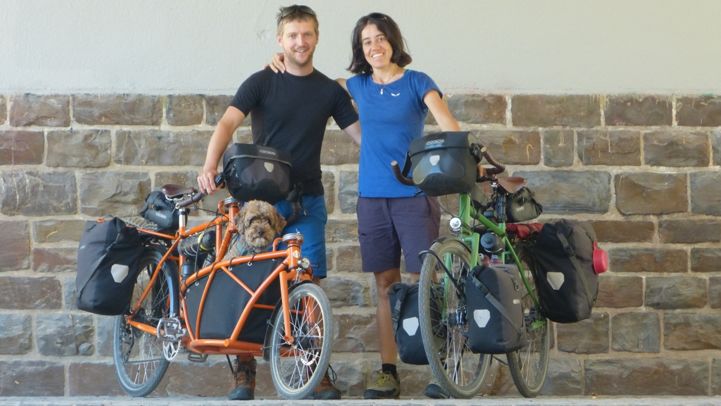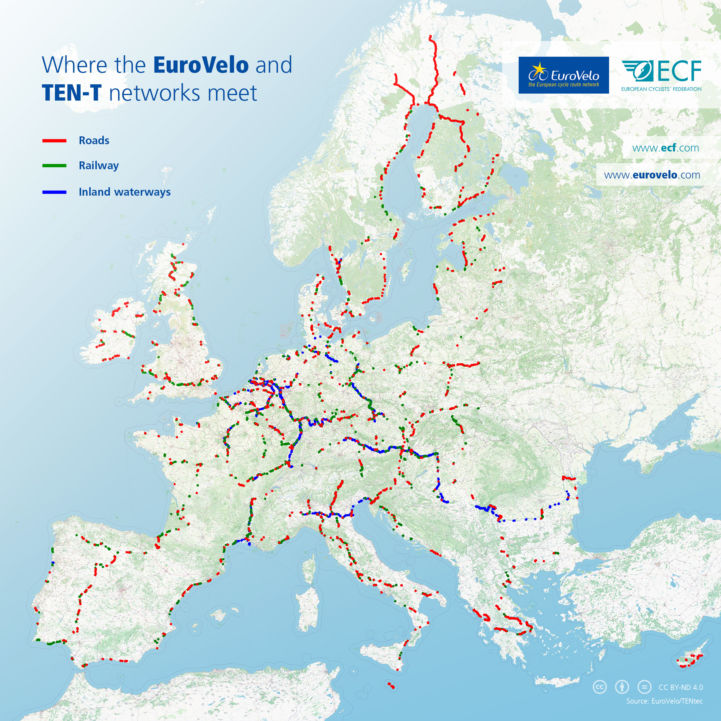Seven countries and 7,237 kms to draw the largest GPS (bike) drawing in history, showing that bicycles will save the world!
Italian-British couple, Arianna Casiraghi and Daniel Rayneau-Kirkhope, along with their dog Zola, cycled 7,237 km to draw a huge shape of a bicycle across the map of Europe using GPS tracking data. The two former research physicists initially embarked on the endeavour in 2019 after selling their car. The aim of the project was to raise as much awareness as possible about cycling’s potential to cut transport emissions and combat the worsening climate crisis.
The couple’s adventure, titled “Bicycles will save the world”, has been featured in news sites and publications in Spain, the UK, France and Italy. The adventure was well documented with photos and posts on social media as part of the record attempt.
Overall, it took the team 131 days to complete the drawing that spanned a large chunk of Western Europe: including, France, Germany, Switzerland, Austria, The Netherlands, Belgium and Luxembourg. During their trip they crossed several EuroVelo routes but weren't able to follow them for long (because unfortunately the EuroVelo network is not bicycle-shaped!). They relied upon long-distance cycling networks such as warmshowers.org for hospitality from strangers along the route and camped out wherever it was possible. Zola, the dog, was lucky enough to ride up front in Daniel’s custom self-built cargo bike that offered her prime views of the path ahead and even shade when necessary in the summer months.
Unfortunately, due to injury and COVID-19 restrictions, their attempt to break the official Guinness World Record was no longer valid when the attempt was paused part of the way through. However, though a bit upset not to set a new record, they have nonetheless set an unofficial world record, beating the previous record of 7,163.67 km, which was obtained by multiple means of transport. They also beat the previous unofficial world record for the biggest GPS drawing undertaken by bike, which was 4,106 km. “Far more importantly, we are quite happy to have drawn the biggest bicycle ever!”

International bicycle traffic exists!
As shown by Daniel and Arianna, international cycle traffic is a fact and sometimes exceeds car or rail passenger traffic in some places. Some of the areas in which the trio passed are actually crucial transit areas for international cyclists. For example, almost 360,000 cyclists crossed the German-Swiss border between Weil-am-Rhein and Basel in 2018 whilst 230,000 crossed the Austrian-Swiss border near St. Margrethen all on EuroVelo 15 Rhine Cycle Route (a route that ECF CEO Jill Warren also happened to traverse this summer!).
How will bicycles save the world?
Cross-border cycling infrastructure can open up a world of potential for leisure and everyday cycling, the continent-spanning GPS drawing highlights the potential of the humble bicycle for encouraging such sustainable development. ECF has been campaigning for cycling’s rightful inclusion within the European Commission’s flagship transport policy, the TEN-T network.
We are arguing that if Europe is to take its net zero ambitions seriously, then we must act immediately with the tools currently available to us to reduce emissions whilst sustainably developing our economies and providing opportunities to all. Cross border cycling infrastructure must be part of this. Including the EuroVelo long-distance cycling network within the TEN-T would go a long way to securing cycling’s rightful place in our toolbox of effective climate solutions.
TEN-T infrastructure development projects are often huge missed opportunities to develop cycling infrastructure alongside other infrastructural investments at a fraction of the entire cost of the project. Furthermore, if cycling is not recognised it is also often the case that such large infrastructure projects negatively impact local cycling networks. Whereas the opposite can also be true in that well developed long-distance cycle routes can serve to encourage the development of surrounding local networks.

Overall, getting more people out and about on their bicycles instead of their cars will be a win-win-win situation by improving EU citizens’ quality of life, reducing overall congestion on EU transport networks and drastically cutting transport emissions.
Hopefully, the awareness raising efforts made by Arianna, Daniel and Zola, combined with our ongoing campaign, are enough to convince more decisionmakers that cycling is a serious solution that we can’t afford to ignore going forward.
Author: Ben Luoma